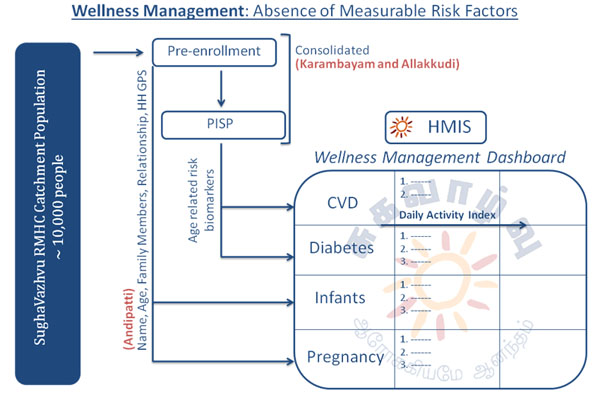By Zeena Johar, President – ICTPH
SughaVazhvu Healthcare is a Thanjavur based not-for-profit organisation. With its vision of “A Disease-free Rural India” and a mission to “Provide Managed Healthcare for Rural Indian Populations”, SughaVazhvu Healthcare is close to the launch of its third Rural Micro Health Centre (RMHC) in Andipatti. The core strength of SughaVazhvu is to establish village-based, medical-practitioner supervised, nurse-managed, primary healthcare delivery systems. The recent restructuring effort at SughaVazhvu instituted the Audit Team, calling for better compliance of processes and outcomes. Through this post a role definition of the Audit Team debating the expected functionalities to ensure standardised healthcare delivery across the entire RMHC network is listed.
Wellness Management at SughaVazhvu Healthcare
The defined routine schedule of a SughaVazhvu Guide, Nurse and Doctor needs to converge towards our one common goal of Human Capital enhancement, attained through Population Wellness Management. The definition of Wellness Management within the SughaVazhvu context pertains towards ensuring the absence of measurable risk factors for all members within the population cohort.
Within the SughaVazhvu RMHC network various models of individual enrollment have been piloted. Karambayam RMHC, built further on the geo-tagged seed data set as obtained from our partner financial institution, wherein executing a household based risk factor analysis through the Population-based Individual Screening Protocol (PISP), realised the complete enrolment process.
At Andipatti, the data collection exercise has helped SughaVazhvu evolve a pre-enrolment strategy, wherein for all House Holds (HH), initial information pertaining to the residing members, their age, gender, relationship and the geo-tag coordinate of the HH is obtained through an intensive field exercise facilitated by Android-based GPS-enabled mobile phones. PISP forms the basis of complete enrolment of an individual in the SughaVazhvu Health Management Information Systems (HMIS). All individuals screened for their age-specific risk biomarkers through the PISP are considered a part of the RMHC Population Cohort.
The role of an RMHC Nurse as a Wellness Manager initiates from the point of complete enrolment of an individual in the SughaVazhvu HMIS. For all visits to the RMHC (only exception being emergencies), the RMHC Nurse follows the patient management protocol to ensure complete enrolment, followed by clinical protocols providing optimum care to served individuals.
For a given RMHC, the Wellness Management Dashboard feature within the HMIS helps a RMHC Nurse better organise her daily schedule. As the HMIS database for a RMHC organically evolves the various risk categories as shown in the figure e.g. CVD, Diabetes, Infants and Pregnancy continue to populate based on the individual risk profile. For disease conditions such as CVD and Diabetes biomarkers such as BP, BMI, Waist Circumference, Age, Gender, Fasting Glucose levels will determine the relevant pharmacological and non-pharmacological intervention. The RMHC based Wellness Management also entails targeting vulnerable/high-risk age groups/conditions e.g. infants between 0 and 2 years of age, because of their elevated individual management requirement e.g. growth monitoring, immunisation adherence, and nutritional supplementation.

In our attempt to deliver standardised primary healthcare across the wide spread network of RMHCs it is important for us to ensure process compliance, but what is crucial for us is to build a culture of local ownership of wellbeing of the served community by their RMHC. For us to achieve this outcome-driven accountability, the granularity with which the day of a SughaVazhvu Nurse and Guide are defined is critical. The daily schedule should reflect and mirror the envisaged vision of enhancing human capital allowing an objective yet comprehensive assessment of provisioned care through the SughaVazhvu network.
The principle guidelines defining the audit parameters at SughaVazhvu are process compliance, people capability assessment and outcome performance. Process Compliance entails regular assessment of the RMHC staff for Wellness Management Protocol Compliance, RMHC Protocol Adherence (pre-consultation, consultation and treatment protocols), and RMHC Infrastructure Assessment. The People Capability Assessment is accomplished through regular review of their knowledge and skills pertaining to primary-care medicine and HMIS usage and performance. The key attributes of the attitude assessment include ownership, leadership, adaptability, aptitude and people skills.

Having outlined the integrative Wellness Management Protocol at SughaVazhvu, and the envisaged audit guidelines, for effectively implementing these principles, an additional level of granularity detailing audit activities will align the performance of a RMHC and its management. Protocol compliance at all levels i.e. pre-consultation, consultation and treatment protocols as implemented through the RMHC for all patient visits need to be monitored real-time by the supervising medical practitioner and further reconfirmed by an audit. The entire supervision framework, and approval mechanisms at all levels is configured through the HMIS, hence, remote monitoring and supervision is easily feasible. RMHC standard and infrastructure audit may be scheduled on a weekly basis, through an objective questionnaire which is not limited in its applicability to only medical professionals. This can then further be generalised as the RMHC visitor protocol so as to allow a random, outsider assessment in a specified format. The monthly RMHC staff member (doctor, nurse, and guide) reviews entail assessment through individual score-cards highlighting weak-links, and allowing course-correction. An equal emphasis is laid on customer satisfaction through qualitative surveys of a random sample to closely assess the softer skills of healthcare delivery at the RMHC. The most critical component and activity of the RMHC assessment, is the performance of the RMHC Population Cohort. The Wellness Management of the Population Cohort is tracked through risk-factor performance (controlled / worsened / improved – subject to expected medical exceptions) for identified individuals, directly traceable through the daily activity index of these individuals as indicated in the Wellness Management Dashboard.
Very clearly defining the criteria of patient assessment, treatment and management will allow SughaVazhvu to standardise primary healthcare delivery through a wide spread network across a vast geography. This provides a great leap towards our attempt to deliver managed care to a wider population, wherein Standardising Primary Healthcare is the Key!


Leave a Reply
Be the First to Comment!